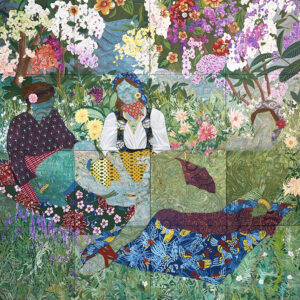Dinorá Justice turns to ‘Mother/Nature’ to reimagine artists’ objectification of women
The Newton artist’s ‘Portraits’ series will be displayed at Gallery NAGA through June 3
The Boston Globe | May 14, 2023
Artist Dinorá Justice was inspired by the opportunity to recast examples of objectification. She looked to Orientalism — the West’s limited depictions of the Eastern world — and the work of renowned 19th- and 20th-century male artists, such as Eugène Delacroix and Henri Matisse. Her art moves their depictions of women’s bodies from intimate, restrictive scenes and places them in nature, among sprawling florals and fronds.
Justice’s 2022 and 2023 “Portraits” series opened May 5 and is on display as a solo exhibition, “Mother/Nature,” at Gallery NAGA on Newbury Street through June 3. The Newton-based artist shifted the gaze of works such as “La Grande Odalisque” by Jean-Auguste-Dominique Ingres and Matisse’s “Reclining Odalisque,” expanding upon, as she explained, women’s connection to nature and how the patriarchy tears both down.
Justice used acrylic marbling with oil paint layered over the top for detail work. “I use the marbling as the skin of the figure and in the background to articulate this idea called ecofeminism — that nature is everything, and everything is interconnected,” she explained. Ecofeminism is a movement and philosophy linking a male-bias society to the domination of both women and the environment, according to the Stanford Encyclopedia of Philosophy.
In her artist statement, Justice wrote: “The celebratory energy of my paintings serves to underline my belief that women and nature must be seen as beneficial partners and that the age-old contempt of the patriarchy for everything it deems ‘feminine’ and ‘weak’ wreaks havoc on the planet and all its living creatures.”
Justice said she sought to explore the ways women and nature have been viewed “as something to be conquered and domesticated and exploited for resources.” The work comments on how the patriarchy tends to view nature as being ‘outside’ when it is interwoven with humanity, she explained.
She said her figures mimic “the contours of the earth” like how art historians suspect Giorgione and Titian’s supine figure in the ”Sleeping Venus” (1510) imitates the landscape behind her. The women’s faces don’t have distinct features, echoing how nature’s features stretch across an environment. Justice also used a Brazilian fabric called chita with bright, colorful flowers in all of her paintings to connect back to her identity as a Latin American artist.
Meg White, the director and owner of Gallery NAGA, praised the sense of community and solidarity among the group of women in Justice’s “Portrait Thirty-seven – after Delacroix’s ‘Women of Algiers.’”
“There’s now an entire group of women, not just a male gaze focused on one figure, but more of a powerful position for women in that they’re together,” she said.
